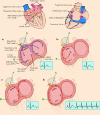Atrial fibrillation
- PMID: 15451840
- PMCID: PMC517863
- DOI: 10.1503/cmaj.1031364
Atrial fibrillation
Abstract
Atrial fibrillation (AF) is the most common sustained dysrhythmia in adults. It is ironic, then, that although mechanisms and effective treatments for most other supraventricular tachyarrhythmias have been discovered, AF remains incompletely understood and poorly treated. Nonetheless, our understanding of the pathophysiology of AF has improved in the last half-century, including some groundbreaking observations made in the last 10 years. Indeed, for some patients, the potential for cure now appears to be available. Because no unifying mechanism of AF has been proven, the aim of this review is to describe some of the common and important concepts behind current mechanistic theories of AF and how they contribute to our clinical understanding of AF.
Figures




Similar articles
-
Atrial fibrillation: mechanistic insights and treatment options.Eur J Intern Med. 2009 Nov;20(7):672-81. doi: 10.1016/j.ejim.2009.07.011. Epub 2009 Sep 27. Eur J Intern Med. 2009. PMID: 19818285 Review.
-
Atrial fibrillation pathophysiology: implications for management.Circulation. 2011 Nov 15;124(20):2264-74. doi: 10.1161/CIRCULATIONAHA.111.019893. Circulation. 2011. PMID: 22083148 Review.
-
[Atrial fibrillation - Links between principles of pathophysiology and treatment].Dtsch Med Wochenschr. 2010 Apr;135(17):862-7. doi: 10.1055/s-0030-1253670. Epub 2010 Apr 20. Dtsch Med Wochenschr. 2010. PMID: 20408106 Review. German.
-
Update on the association of inflammation and atrial fibrillation.J Cardiovasc Electrophysiol. 2010 Sep;21(9):1064-70. doi: 10.1111/j.1540-8167.2010.01774.x. J Cardiovasc Electrophysiol. 2010. PMID: 20455973 Review.
-
Atrial fibrillation-the final frontier.J Cardiovasc Pharmacol Ther. 2010 Dec;15(4 Suppl):36S-50S. doi: 10.1177/1074248410371947. Epub 2010 Oct 12. J Cardiovasc Pharmacol Ther. 2010. PMID: 20940451 Review.
Cited by
-
Understanding the Beat-to-Beat Variations of P-Waves Morphologies in AF Patients During Sinus Rhythm: A Scoping Review of the Atrial Simulation Studies.Front Physiol. 2019 Jun 18;10:742. doi: 10.3389/fphys.2019.00742. eCollection 2019. Front Physiol. 2019. PMID: 31275161 Free PMC article.
-
Global research trends in catheter ablation and surgical treatment of atrial fibrillation: A bibliometric analysis and science mapping.Front Surg. 2023 Jan 6;9:1048454. doi: 10.3389/fsurg.2022.1048454. eCollection 2022. Front Surg. 2023. PMID: 36684348 Free PMC article.
-
Management of Left Atrial Tachyrhythms in the Setting of HFpEF with Pulsed-Field Ablation: Treating Fire with Water?Therapeutics (Basel). 2024 Sep;1(1):42-51. doi: 10.3390/therapeutics1010006. Epub 2024 Sep 23. Therapeutics (Basel). 2024. PMID: 39398098 Free PMC article.
-
In Vitro Models for Improved Therapeutic Interventions in Atrial Fibrillation.J Pers Med. 2023 Aug 8;13(8):1237. doi: 10.3390/jpm13081237. J Pers Med. 2023. PMID: 37623487 Free PMC article. Review.
-
Higher-Order Spectral Analysis Combined with a Convolution Neural Network for Atrial Fibrillation Detection-Preliminary Study.Sensors (Basel). 2024 Jun 27;24(13):4171. doi: 10.3390/s24134171. Sensors (Basel). 2024. PMID: 39000950 Free PMC article.
References
-
- Allessie MA, Bonke FI, Schopman FJ. Circus movement in rabbit atrial muscle as a mechanism of tachycardia. III. The “leading circle” concept: a new model of circus movement in cardiac tissue without the involvement of an anatomical obstacle. Circ Res 1977;41(1):9-18. - PubMed
-
- Moe GK, Rheinboldt WC, Abildskov JA. A computer model of atrial fibrillation. Am Heart J 1964;67:200-20. - PubMed
-
- Rensma PL, Allessie MA, Lammers WJ, Bonke FI, Schalij MJ. Length of excitation wave and susceptibility to reentrant atrial arrhythmias in normal conscious dogs. Circ Res 1988;62(2):395-410. - PubMed
-
- Konings KT, Kirchhof CJ, Smeets JR, Wellens HJ, Penn OC, Allessie MA. High-density mapping of electrically induced atrial fibrillation in humans. Circulation 1994;89(4):1665-80. - PubMed
-
- Cox JL, Canavan TE, Schuessler RB, Cain ME, Lindsay BD, Stone C, et al. The surgical treatment of atrial fibrillation. II. Intraoperative electrophysiologic mapping and description of the electrophysiologic basis of atrial flutter and atrial fibrillation. J Thorac Cardiovasc Surg 1991;101(3):406-26. - PubMed
Publication types
MeSH terms
Substances
LinkOut - more resources
Full Text Sources
Medical
Molecular Biology Databases
